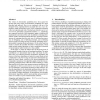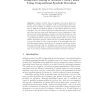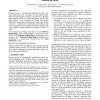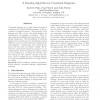VEE
2012
ACM
12 years 10 months ago
2012
ACM
Dynamic Binary Translators (DBT) and Dynamic Binary Optimization (DBO) by software are used widely for several reasons including performance, design simplification and virtualiza...
PPOPP
2012
ACM
12 years 10 months ago
2012
ACM
The virtues of deterministic parallelism have been argued for decades and many forms of deterministic parallelism have been described and analyzed. Here we are concerned with one ...
FASE
2012
Springer
12 years 10 months ago
2012
Springer
Software product lines are families of products defined by feature commonality and variability, with a well-managed asset base. Recent work in testing of software product lines ha...
PLDI
2011
ACM
13 years 5 months ago
2011
ACM
For more than thirty years, the parallel programming community has used the dependence graph as the main abstraction for reasoning about and exploiting parallelism in “regular�...
VLDB
1993
ACM
14 years 7 months ago
1993
ACM
The enforcement of semantic integrity constraints in data and knowledge bases constitutea a major performance bottleneck. Integrity constraint simplification methods aim at reduci...
SIGSOFT
1994
ACM
14 years 7 months ago
1994
ACM
Program slicing is a fundamental operation for many software engineering tools. Currently, the most efficient algorithm for interprocedural slicing is one that uses a program repr...
SIGSOFT
1994
ACM
14 years 7 months ago
1994
ACM
A dependence model for reverse engineering should treat procedures in a modular fashion and should be fine-grained, distinguishing dependences that are due to different variables....
CC
2003
Springer
14 years 8 months ago
2003
Springer
We define the Value State Dependence Graph (VSDG). The VSDG is a form of the Value Dependence Graph (VDG) extended by the addition of state dependence edges to model sequentialise...
VL
2003
IEEE
14 years 8 months ago
2003
IEEE
Constraint diagrams are a visual notation designed to complement the Unified Modeling Language in the development of software systems. They generalize Venn diagrams and Euler cir...
SCAM
2003
IEEE
14 years 8 months ago
2003
IEEE
The Program Dependence Graph was introduced by Ottenstein and Ottenstein in 1984. It was suggested to be a suitable internal program representation for monolithic programs, for th...




